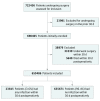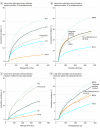Association of Postoperative Infection With Risk of Long-term Infection and Mortality
- PMID: 31693076
- PMCID: PMC6865239
- DOI: 10.1001/jamasurg.2019.4539
Association of Postoperative Infection With Risk of Long-term Infection and Mortality
Erratum in
-
Error in Figure.JAMA Surg. 2020 Jan 1;155(1):94. doi: 10.1001/jamasurg.2019.5520. JAMA Surg. 2020. PMID: 31940028 Free PMC article. No abstract available.
Abstract
Importance: Surgical site infection has been shown to decrease survival in veterans by up to 42%. The association of 30-day postoperative infections with long-term infections in the overall surgical population remains unknown.
Objective: To determine whether exposure to 30-day postoperative infection is associated with increased incidence of infection and mortality during postoperative days 31 to 365.
Design, setting, and participants: In this retrospective observational cohort study, veterans undergoing major surgery through the Veterans Health Administration from January 2008 to December 2015 were included. Stabilized inverse probability of treatment weighting was used to balance baseline characteristics of the control and exposure groups. Cox proportional hazards regression was used to estimate hazard ratios of long-term infection and mortality. Data were analyzed from September 2018 to May 2019.
Exposures: Any 30-day postoperative infection (exposure group) vs no 30-day infection (control group).
Main outcomes and measures: Number of days between index surgery and the occurrence of death or the patient's first infection during postoperative days 31 to 365. Patients who died before having a long-term infection were censored for the infection outcome.
Results: Of the 659 486 included patients, 604 534 (91.7%) were male, and the mean (SD) age was 59.7 (13.6) years. Among these patients, 23 815 (3.6%) had a 30-day infection, 43 796 (6.6%) had a long-term infection, and 24 810 (3.8%) died during follow-up. The most frequent 30-day infections were surgical site infection (9574 [40.2%]), urinary tract infection (6545 [27.5%]), pneumonia (3515 [14.8%]), and bloodstream infection (1906 [8.0%]). Long-term infection types included urinary tract infection (21 420 [48.7%]), skin and soft tissue infection (14 348 [32.6%]), bloodstream infection (3862 [8.8%]), and pneumonia (2543 [5.8%]). Patients in the exposure group had a higher observed incidence of long-term infection (5187 of 23 815 [21.8%]) and mortality (3067 of 23 815 [12.9%]) compared with those without 30-day infection (38 789 of 635 671 [6.1%] and 21 743 of 635 671 [3.4%], respectively). The estimated hazard ratio for long-term infection was 3.17 (95% CI, 3.05-3.28) and for mortality was 1.89 (95% CI, 1.79-1.99).
Conclusions and relevance: At any given point during the follow-up period, patients with 30-day postoperative infection had a 3.2-fold higher risk of 1-year infection and a 1.9-fold higher risk of mortality compared with those who had no 30-day infection. Cost-benefit calculations for surgical infection prevention programs should include the increased risk and costs of long-term infection and death. Preventive efforts in the first 30 days postoperatively may improve long-term patient outcomes.
Conflict of interest statement
Figures



Comment in
-
Postoperative Infection-A Pervasive Mediator of Patient Mortality.JAMA Surg. 2020 Jan 1;155(1):68. doi: 10.1001/jamasurg.2019.4554. JAMA Surg. 2020. PMID: 31693065 No abstract available.
-
Implications of Postoperative Infections on Long-term Outcomes-Reply.JAMA Surg. 2020 Jul 1;155(7):668. doi: 10.1001/jamasurg.2020.0419. JAMA Surg. 2020. PMID: 32267473 No abstract available.
-
Implications of Postoperative Infections on Long-term Outcomes.JAMA Surg. 2020 Jul 1;155(7):667-668. doi: 10.1001/jamasurg.2020.0418. JAMA Surg. 2020. PMID: 32267493 No abstract available.
References
Publication types
MeSH terms
LinkOut - more resources
Full Text Sources
Medical

